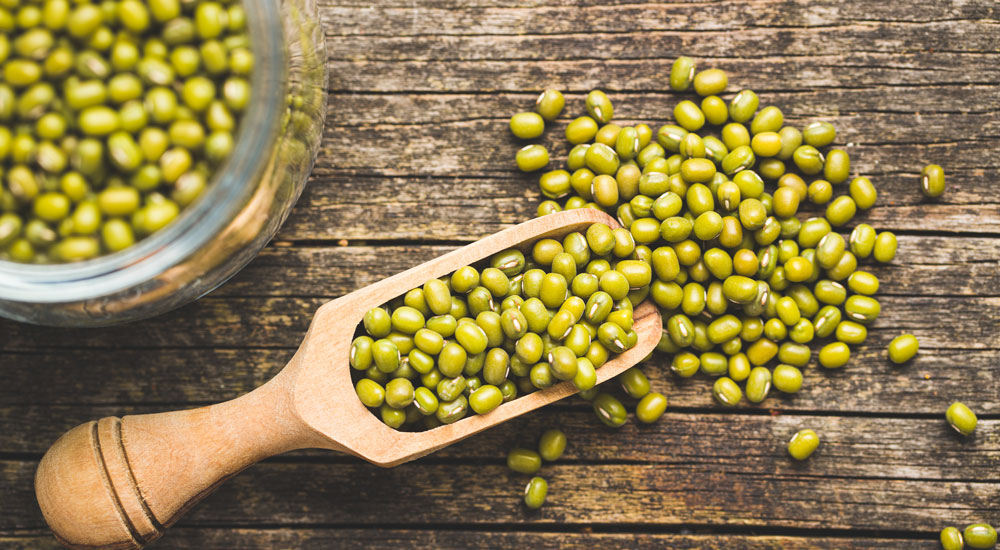
What the Heck are Mung Beans?
Mung beans are showing up on ingredient lists of plant-based foods including the Beyond Burger. I wasn’t familiar with them, and thought what the heck are mung beans? So my team did a bit of research and this is the overview.
They are grown mainly in Southeast Asia, Africa, South America and Australia, but can be grown in North America. They have a slightly sweet, nutty taste. They’re cooked whole in foods such as soups or curries. And they are commonly sprouted to make a bean sprout used in stir-fries and salads. In addition, if eaten undercooked, mung bean may cause digestive concerns including nausea and diarrhea. Let’s explore more about these little green beans.
Mung Beans and Health
The nutritional interest in mung beans for plant-based foods is mostly due to its high protein content at 24 grams per 100 grams. Plus they contain significant amounts of the branch chained amino acids leucine, isoleucine and valine that are usually lacking in other plant-based ingredients. They have a high folate content, plus are a good source of soluble fibre.
Heart Health
Being high in soluble fibre, mung beans have the potential to be heart healthy. In an animal study fermented mung bean reduced serum lipid levels a factor in reducing the risk for Cardiovascular Disease (1). In a rat study, using hyperlipidemia rats, it was demonstrated that hydroalcoholic extract from the mung bean reduced the risk factors including LDL, triglycerides, VLDL and total serum cholesterol (2). Overall, mung bean shows potential heart health benefits. However, human trials are required to prove the exact effect.
Immune Health
Cancer risk reduction is a potential benefit of consuming mung beans. Mung beans are high in fibre, which can reduce the risk of colorectal cancer (3). In vitro studies using mung bean found that it has an antiproliferation effect on cancers of the digestive tract, breast, and ovaries (4). Also mung beans are high in phenolic antioxidants and when consumed may decrease the risk for cancers (5). Based on preliminary studies, mung beans have the potential to decrease the risk of cancers and reduce cancer cell proliferation. However, human trials are necessary to define the specific relationship.
Women’s Health
Mung beans are high in folate, at 625 mcg per 100 gram. The folate recommendation for women that are of reproductive age is 400 mcg and is 600 mcg for pregnant women (6). Overall, the high folate content of mung bean, if consumed during pregnancy and before conception, may decrease the risk of neural tube defects.
 What’s Next?
What’s Next?
On the whole, mung beans are fairly new to the North American consumer. They are high in protein, and folate with the potential of heart, immune and women’s health benefits. However, human clinical studies must be conducted to explain the dose response relationship and health benefits.
Remember no single food or ingredient is a silver bullet. A lifestyle filled with healthy habits including a balanced dietary pattern, exercise and restful sleep is the best approach for long-term consistent, mind body health. If you have added mung beans to your healthy diet, let me know your thoughts about the flavour, texture and how you use it!
Jane and her team would love to assist your company to get into the latest food and health trends or speak at your upcoming event!
Click here to learn more.
References:
- Yeap SK, Beh BK, Ho WY, Mohd Yusof H, Mohamad NE, et al. In Vivo Antioxidant and Hypolipidemic Effects of Fermented Mung Bean on Hypercholesterolemic Mice. Evidence-Based Complement Altern 2015:1–6.
- Solanki YB, Jain SM. Antihyperlipidemic activity of Clitoria ternatea and Vigna mungo in rats. Pharm Biol. 2010 Aug 2; 48(8):915–23.
- Aune D, Chan DSM, Lau R, Vieira R, Greenwood DC, et al. Dietary fibre, whole grains, and risk of colorectal cancer: systematic review and dose-response meta-analysis of prospective studies. BMJ. 2011 Nov 10; 343:d6617.
- Ganesan K, Xu B. A critical review on phytochemical profile and health promoting effects of mung bean ( Vigna radiata ). Food Sci Hum Wellness 2018 Mar; 7(1):11–33.
- Anwar F, Latif S, Przybylski R, Sultana B, Ashraf M. Chemical Composition and Antioxidant Activity of Seeds of Different Cultivars of Mungbean. J Food Sci. 2007 Sep; 72(7):S503–10.
- Dietary Reference Intake
Copyright © 2019 Jane Dummer | All Rights Reserved
